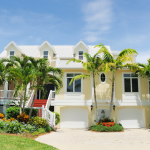Home insurance and hazard insurance are two terms often used interchangeably, but they’re not the same. While they both provide coverage for damages to your property, there are essential differences between the two.
Main Differences Between Home and Hazard Insurance
We’ll get into more specifics in the next section, but here are the 3 main differences between homeowners insurance and hazard insurance.
- Scope: Homeowners insurance provides broader coverage for a wide range of events that could damage your property, while hazard insurance provides coverage for specific perils or hazards named in the policy.
- Liability: Homeowners insurance typically includes liability coverage, which can protect you from lawsuits if someone is injured on your property. Hazard insurance typically covers damage to the structure of your home, but it may not cover damage to personal property or liability claims unless called out specifically in the policy documents.
- Cost: Homeowners insurance is generally more expensive than hazard insurance because it provides broader coverage. The cost of homeowners insurance varies depending on several factors, including the value of your home, the deductible you choose, and the amount of coverage you need.
Now, let’s explore how homeowners insurance differs from hazard insurance in more detail.
What is Homeowners Insurance?
Homeowners insurance is a type of policy that provides coverage for your home and personal property from situations that involve things like fire, theft, vandalism, and other events like storms, hail, and lightning. It typically includes the following four types of protection.
Dwelling coverage:
- This covers the cost to repair or rebuild your home if it’s damaged or destroyed by a covered event, such as a fire, hailstorm, or windstorm. You’ll want a policy that will cover the full amount should you need to rebuild your home from the ground up in the event of a total loss.
- Attached structures — like your garage, a deck, or a porch — will likely be covered by dwelling insurance. Other structures — like unattached garages, pool houses, sheds, and even fences — can be included at varying levels of coverage but are not typically automatically covered as a “dwelling.”
Personal belongings:
- This provides protection to repair or replace your personal possessions — like furniture, clothing, and electronics — if they’re damaged or destroyed by a covered event. Coverage limits for personal belongings are typically a percentage of your dwelling coverage limit.
- Some policies may limit coverage for certain items altogether. For example, expensive jewelry and rare artwork may require separate policies. Make sure to keep an inventory of your belongings and their value to help make the claims process smoother in the event of a loss.
Personal Liability:
- This covers your legal responsibility if someone is injured on your property or if you cause damage to someone else’s property. It can help pay for medical bills, damages, or legal fees — like if you’re sued for something like a slip-and-fall accident on your property or if your dog bites someone.
- Personal liability coverage typically has limits that start at $50,000 to $100,000. You might want to consider an umbrella policy for additional liability protection.
Loss of use:
- if your home becomes uninhabitable due to a covered event, this coverage provides reimbursement for additional living expenses — like hotel bills, food, and other costs — incurred while your place is being repaired or rebuilt. Keep all receipts to make the claims process smoother down the road.
- Typically, coverage limits for loss of use are calculated as a percentage of your dwelling coverage limits, so make sure you have adequate coverage for your family size and situation.
What Is Hazard Insurance?
Hazard insurance is sometimes called “peril” or “catastrophe” insurance. It provides coverage for specific risks that either occur naturally or are man-made.
Unlike homeowners insurance, which covers a broad range of events, hazard insurance covers only events spelled out in the policy. So, with that in mind, some things on the following list of perils may be covered in your homeowners policy, while some may not. You’ll want to talk to your insurance provider to ensure you get the proper coverage.
Let’s look at some common “perils” that you could choose to have covered by hazard insurance:
- Fire: This covers damage caused by flames or combustion to structures, personal property, and belongings.
- Smoke: Similar to the above, this is coverage specifically for damage caused by smoke from a covered peril, such as a fire or a malfunctioning furnace.
- Lightning: While thunder is pretty tame, lightning — the atmospheric electrical discharge — can do some major damage to your home and can cause electrical surges and fires.
- Windstorm or hail: Depending on where you call home, you might want additional coverage for damage caused by high winds, tornadoes, and hailstones, which can wreak havoc on roofs, windows, and other parts of your home.
- Fallen trees: Damage to the roof, windows, and other parts of your home caused by fallen trees can also be covered by your individual hazard insurance.
- Explosion: This covers damage caused by a blast of gas or other materials that can damage your home’s foundation, walls, and belongings.
- Aircraft or vehicle damage: Live near an airport or a major thoroughfare? Consider this coverage for damage caused by cars, trucks, or other vehicles that collide with your home or property (or, in the case of airplanes, if something falls from the aircraft and crashes into your home.)
- Riot or civil commotion: We see this all over the news recently, and it’s caused a rise in inquiries on how to protect against property damage due to vandalism and theft related to rioting, protesting, and civil unrest.
- Vandalism or malicious mischief: Similar to the previous peril, this coverage is damage caused by intentional and malicious acts, including vandalism, graffiti, and destruction of property unrelated to a rioting incident.
- Theft: This coverage protects against loss or damage of personal property, including electronics, jewelry, and other valuable items, due to theft or attempted theft.
MORE: Remember, some of these hazards might be covered in a broader homeowners policy. If not, know that you can get protection for these events via hazard insurance. To dig in further, check out some perils which definitely aren’t covered in the typical homeowners insurance policy!
What About Earthquakes, Floods, and Hurricanes?
You’ll notice a few perils that aren’t listed in either the homeowners insurance or hazard insurance breakouts, and that’s because they’re so very devastating. These are earthquakes, floods, and hurricanes.
While specific policies for earthquakes and floods exist, hurricanes are another matter. Standard homeowners insurance policies may cover wind damage caused by a hurricane but may not cover damage caused by flooding. Depending on where you live and the level of risk in your area, you may need to purchase separate flood insurance combined with windstorm hazard insurance policies to ensure adequate coverage for hurricane-related damage.
Additionally, these types of insurance policies are often required by mortgage lenders if your property is located in a high-risk area for that specific type of event, so it’s essential to review your insurance needs and talk to your insurance agent to understand what is and is not covered under your policy.
Let’s Get You Covered!
While both homeowners insurance and hazard insurance provide coverage for property damage, they differ in terms of what they cover. Homeowners insurance provides broader protection for a range of potential risks, while hazard insurance policies are specifically designed to protect against explicit hazards or dangers.
Understanding these differences can help you choose the right insurance coverage to meet your needs and protect your home and personal property.
If you’re ready to learn more about homeowners or hazard insurance, contact the Guided Solutions team. Or request a quote today.









